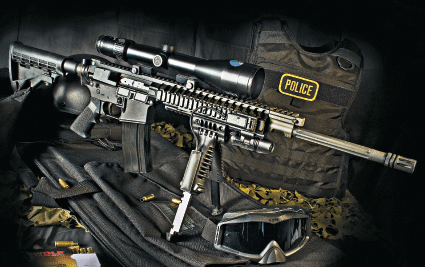I’ve always heard that it’s impossible to please everyone. Maybe so, but consider the newest AAR15, a gas piston-operated rifle chambered in the 6.5 Grendel from Alexander Arms.
Proponents of replacing Eugene Stoner’s design have a few complaints. First, many of these people were alive when GIs were issued a .30-caliber battle rifle. Replaced by a terminally inferior cartridge, this is the major issue driving the debate and recent solicitations for an M4 replacement. Second, the original direct impingement gas operated system has often been blamed for deadly malfunctions on the battlefield. Thirdly, we’ve become spoiled with modularity and the Picatinny rail system that permits the attachment of so many accessories.
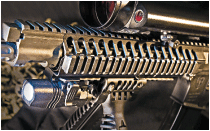 Can we have it all? Is there a choice that solves all of these problems? Bill Alexander thinks so. According to him, we don’t have to choose between “minimum weight and maximum performance.”
Can we have it all? Is there a choice that solves all of these problems? Bill Alexander thinks so. According to him, we don’t have to choose between “minimum weight and maximum performance.”
Advertisement — Continue Reading Below
The US military currently runs on a two-cartridge system. For close encounters of the hostile kind, we have the 5.56mm NATO, a relatively short-range cartridge for infantry rifles and light machine guns. For those longer ranges, the 7.62mm NATO feeds the chamber of many sniper rifles and medium machine guns. Bill Alexander’s final form of the 6.5 Grendel chambering challenges the two-cartridge system with one that performs extremely well at both close and long ranges.
Designed as a low-recoil, high accuracy, long-range cartridge, the Grendel’s design philosophy has been called “start slow and end fast.” High muzzle velocities accelerate barrel wear and increase the amount of felt recoil. Constrained by the length of a 5.56mm NATO cartridge but wanting a heavier bullet with a high ballistic coefficient, the Grendel’s short, fat case permits a higher powder volume. Loads range between a 90- and 129-grain bullet with velocities spanning between 2500 to 2900 fps (feet per second).
The 6.5 Grendel has a flatter trajectory and retains greater terminal energy at extended ranges than other cartridges of a similar nature due to its higher ballistic coefficient. Production rifles have consistently achieved sub-MOA groups at ranges past 600 meters. On March 6, 2006, Arne Brennan shot a witnessed group at the long range of 660 yards that measured only 1.20 inches.
Advertisement — Continue Reading Below
Check out our article about the Whitetail AR: Alexander Arms’ Game-Taking 6.5 Grendel
Alexander Arms contracted Speer Law Enforcement to perform terminal ballistic tests in accordance with FBI protocols and procedures. With results made public in May of 2006, all tests were completed using either a 14.5- or 16-inch chrome-lined barrels shot from 50 and 100 yards to simulate combat conditions. Barrel pressures were less than 50,000 psi (pounds per square inch) and the 123-grain projectile penetrated 2 inches in 10-percent ballistic gelatin before yawing and fragmenting.
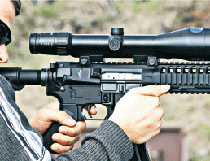 The Grendel case design has a large internal capacity after shifting the shoulder forward and increasing the thickness in the case’s neck and shoulder. The external taper of the case and the robust features make this cartridge capable of being fed reliably through a magazine into an AR-style rifle.
The Grendel case design has a large internal capacity after shifting the shoulder forward and increasing the thickness in the case’s neck and shoulder. The external taper of the case and the robust features make this cartridge capable of being fed reliably through a magazine into an AR-style rifle.
Advertisement — Continue Reading Below
Gun Details
The AAR15 is the latest product to come from Alexander Arms’ shop. Built as an entirely new platform, Bill Alexander chose to select high-quality components in developing the first gas-piston-operated rifle chambered in his 6.5 Grendel cartridge. “My rifles never had a problem with the original direct impingement design, but we got so many calls from customers asking for a gas-piston-operated Grendel that I had to look at it,” says Alexander.
Alexander Arms determined the PWS (Primary Weapons Systems) Piston System to be best suited for his 6.5 Grendel and went to work. Created in response to the credit given to the AK47’s battlefield reliability, the familiar ergonomics of the Stoner platform required a retro-fit. Using Alexander Arms’ chromed bolt carrier group, the PWS system starts with a modified carrier key and an anti-shear pin. The new operating rod is pressure fitted into the carrier key while the gas block assembly is installed and pinned in place.
When the AAR15 is fired, the gas pressure forming inside the new gas block pushes against a short stroke piston that drives the operating rod rearward and imparts momentum on the bolt carrier, thus continuing the cycle of operation. The piston travels 0.75 of an inch before expelling all unused gas from a small vent in the bottom of the piston tube. As the cycle of operation continues, the piston is pushed back into battery by the returning operating rod.
Advertisement — Continue Reading Below
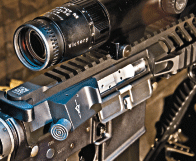 The upper receiver with an integral Picatinny forend comes from Vltor, a rigid flat-top called the VIS (Versatile Interface Structure). The VIS gives the AAR15 a thicker wall that contributes to greater reliability and accuracy while extending the life of components like the bolt carrier group and barrel. The most visible difference between the Vltor’s upper and others is the unique shell deflector housing the forward assist and the integrated Picatinny rail forend. If you look just above the charging handle, you may also see a coded serial number on top of the upper that can be scanned for quicker inventories when stored in rifle racks.
The upper receiver with an integral Picatinny forend comes from Vltor, a rigid flat-top called the VIS (Versatile Interface Structure). The VIS gives the AAR15 a thicker wall that contributes to greater reliability and accuracy while extending the life of components like the bolt carrier group and barrel. The most visible difference between the Vltor’s upper and others is the unique shell deflector housing the forward assist and the integrated Picatinny rail forend. If you look just above the charging handle, you may also see a coded serial number on top of the upper that can be scanned for quicker inventories when stored in rifle racks.
Every AAR15 upper is fitted with a fluted Satern button-rifled barrel built to Bill Alexander’s specifications. The twist rate for the 18-inch Grendel is 1 turn in 7.5 inches. “The twist rate for the 6.5 caliber must be carefully matched to the application for the best results, and one should note that we do not refer to 100-yard accuracy,” says Bill Alexander. “This is because the ideal twist for such a range would not work well at longer ranges with heavier bullets,” he concludes.
Optics Selection
I fitted the Vltor flattop with a Zeiss Victory Diarange 3-12x56T with a built-in laser rangefinder. I tested the rangefinder by itself previously and determined its impressive accuracy on land and across water just beyond 900 yards. It’s an expensive piece of equipment but when lives depend on accuracy, I can’t think of a substitute.
Advertisement — Continue Reading Below
The Zeiss Diarange features an integrated rangefinder that uses a Class 1 laser, non-visible and safe to the eyes. Optical performance is just what you would expect from Zeiss with mechanical reliability and an integrated rail system that mounts fast and is adaptable. The scope’s tube is recoil proof, waterproof and nitrogen filled. The optional Rapid Z reticule features a bullet drop compensator with stadia lines marked for 200, 300, and 400 yards.
Operating the rangefinder on the Zeiss is simple. Sight the target using the reticule and use the left hand to push a button towards the objective lens located under the scope. As the laser is reflected off the targeted object, a highly precise timer and microprocessor helps to determine the distance based on the elapsed time between sending and receiving the signal. The maximum time it takes for the scope to read a distance is just half a second.
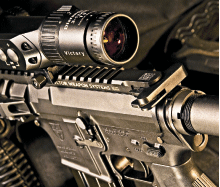 Shooting Impressions
Shooting Impressions
Time behind the AAR15 on the range revealed a lot of things. My first impression was that the single-stage trigger felt like a two-stage. It had a creep during take-up that was very distracting. After measuring an average pull of 7.25 pounds, I could tell that this setup was targeting use by regular infantry. I’ve tested other rifles from Alexander Arms before with their unique Tactical Trigger that breaks in a crisp single-stage manner and I longed for such a feature on this rifle. But this is where my complaints end.
Advertisement — Continue Reading Below
Fighting through the trigger and against patience, I had to time each shot between 25-mph wind gusts while testing the AAR15 at 100 yards. When I did fire, I noticed that the rifle’s recoil felt very linear, pushing gently into my shoulder. The Zeiss Diarange Rapid Z reticule helped enormously in timing an optimal shot under these conditions. I started the tests shooting five 5-shot groups from a bench using Wolf’s Gold 120-grain copper jacketed MPT (Multi-Purpose Tactical) load. Groups started out with a best 0.87 of an inch group (measured center-to-center) but grew the more I shot. The 5-shot group average using Wolf ammunition resulted in 1.08 inches.
I took a break before loading the magazines with Alexander Arms’ own 123-grain Lapua-cased Scenar loaded ammunition. Each box comes distinctly packaged with 20 rounds of factory loaded 6.5 Grendel cartridges. The quality standards that Bill Alexander holds are unmatched. Five 5-shot groups averaged 0.99 of an inch with a best group measuring just 0.72 of an inch at 100 yards.
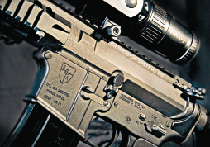 Recoil wasn’t an issue in reacquiring the target during a 50-yard function test on a 12×18-inch steel target. The AAR15 steel magazine designed specifically for use with the 6.5 Grendel worked perfectly as I set off each round with rapid succession. I didn’t see a plume of smoke from either brand of ammunition as I had expected with this piston driven rifle.
Recoil wasn’t an issue in reacquiring the target during a 50-yard function test on a 12×18-inch steel target. The AAR15 steel magazine designed specifically for use with the 6.5 Grendel worked perfectly as I set off each round with rapid succession. I didn’t see a plume of smoke from either brand of ammunition as I had expected with this piston driven rifle.
Advertisement — Continue Reading Below
Final Notes
Order the AAR15 with Bill Alexander’s Tactical Trigger and the AAR15 may actually please everyone. Reliability achieved by piston-driven operation, modularity in Stoner’s platform, accuracy by closely held tolerances and a cut-rifled barrel, and optimal terminal ballistics delivering a flat-shooting, heavy-hitting cartridge.
